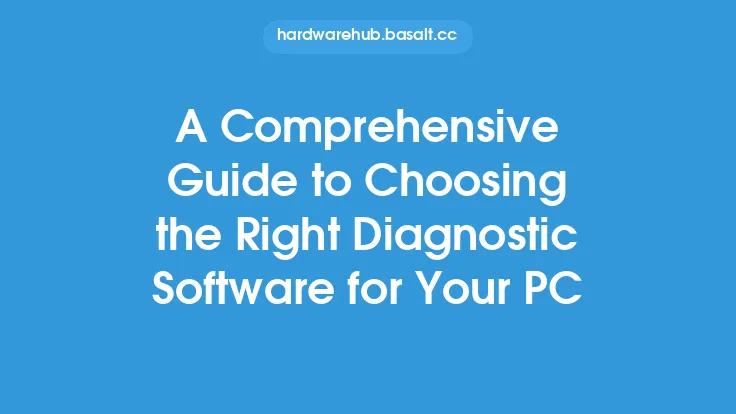When it comes to troubleshooting hardware issues, having the right tools at your disposal can make all the difference. One such tool that is often overlooked but can be incredibly useful is the diagnostic card. A diagnostic card is a specialized card that can be inserted into a computer's expansion slot to provide detailed information about the system's hardware components. In this article, we will explore the world of diagnostic cards, how they work, and how to use them to troubleshoot common hardware issues.
What are Diagnostic Cards?
Diagnostic cards are essentially specialized cards that are designed to provide detailed information about a computer's hardware components. They are typically inserted into a computer's expansion slot, such as a PCI or PCIe slot, and can provide a range of information about the system's hardware, including temperature readings, voltage levels, and fan speeds. Diagnostic cards can be used to troubleshoot a wide range of hardware issues, from simple problems like faulty fans or overheating components to more complex issues like malfunctioning RAM or CPU problems.
How Do Diagnostic Cards Work?
Diagnostic cards work by using a combination of sensors and software to monitor the system's hardware components. The card is typically equipped with a range of sensors, including temperature sensors, voltage sensors, and fan speed sensors, which provide real-time data about the system's hardware. This data is then transmitted to the card's software, which interprets the data and provides a detailed report about the system's hardware components. The software can also be used to configure the card's settings, such as setting temperature thresholds or configuring fan speeds.
Types of Diagnostic Cards
There are several types of diagnostic cards available, each with its own unique features and capabilities. Some common types of diagnostic cards include:
- Temperature monitoring cards: These cards are designed to monitor the temperature of the system's hardware components, including the CPU, GPU, and motherboard.
- Voltage monitoring cards: These cards are designed to monitor the voltage levels of the system's hardware components, including the power supply, motherboard, and RAM.
- Fan control cards: These cards are designed to monitor and control the system's fans, including setting fan speeds and monitoring fan performance.
- System monitoring cards: These cards are designed to provide a comprehensive overview of the system's hardware components, including temperature readings, voltage levels, and fan speeds.
How to Use Diagnostic Cards for Hardware Troubleshooting
Using a diagnostic card to troubleshoot hardware issues is relatively straightforward. Here are the general steps to follow:
- Insert the diagnostic card into an available expansion slot on the motherboard.
- Install the card's software and configure the card's settings as needed.
- Run the card's software to begin monitoring the system's hardware components.
- Use the software to identify any potential issues, such as overheating components or faulty fans.
- Use the card's data to troubleshoot the issue, such as adjusting fan speeds or replacing faulty components.
Common Hardware Issues that Can be Diagnosed with Diagnostic Cards
Diagnostic cards can be used to diagnose a wide range of hardware issues, including:
- Overheating components: Diagnostic cards can be used to monitor the temperature of the system's hardware components, including the CPU, GPU, and motherboard.
- Faulty fans: Diagnostic cards can be used to monitor the performance of the system's fans, including setting fan speeds and monitoring fan performance.
- Power supply issues: Diagnostic cards can be used to monitor the voltage levels of the system's power supply, including identifying issues with the power supply's voltage output.
- RAM and CPU issues: Diagnostic cards can be used to monitor the performance of the system's RAM and CPU, including identifying issues with the RAM's timing or the CPU's clock speed.
Best Practices for Using Diagnostic Cards
To get the most out of a diagnostic card, it's essential to follow best practices for using the card. Here are some tips to keep in mind:
- Always follow the manufacturer's instructions for installing and configuring the card.
- Use the card's software to monitor the system's hardware components regularly, rather than just when issues arise.
- Keep the card's software up to date to ensure that you have the latest features and bug fixes.
- Use the card's data to troubleshoot issues, rather than relying on guesswork or trial and error.
Conclusion
Diagnostic cards are a powerful tool for troubleshooting hardware issues, providing detailed information about the system's hardware components and helping to identify potential problems. By understanding how diagnostic cards work and how to use them, you can take your hardware troubleshooting to the next level and keep your system running smoothly and efficiently. Whether you're a seasoned IT professional or a DIY enthusiast, a diagnostic card is an essential tool to have in your toolkit.





